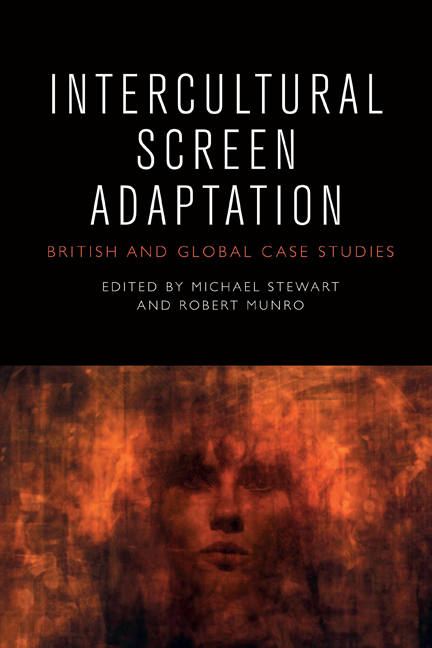Book contents
- Frontmatter
- Contents
- List of Illustrations
- Acknowledgements
- List of Contributors
- Introduction
- PART I NOSTALGIA, HERITAGE AND THE TOURIST GAZE
- 1 Adapting Pagnol and Provence
- 2 ‘A Tourist in Your Own Youth’: Spatialised Nostalgia in T2: Trainspotting
- 3 ‘200 Miles Outside London’: The Tourist Gaze of Far from the Madding Crowd
- PART II RADICAL CONTINGENCIES: NEGLECTED FIGURES AND TEXTS
- 4 Reframing Performance: The British New Wave on Stage and Screen
- 5 Why We Do Not Adapt Jean Rhys
- PART III RE-ENVISIONING THE NATIONAL IMAGINARY
- 6 ‘To see oursels as ithers see us’: Textual, Individual and National Other-selves in Under the Skin
- 7 Back to the Future: Recalcitrance and Fidelity in Julieta
- PART IV THE LOCAL, THE GLOBAL AND THE COSMOPOLITAN
- 8 El Patrón Del Mal: A National Adaptation and Narcos Precedent
- 9 Constructing Nationhood in a Transnational Context: BBC’s 2016 War and Peace
- 10 The Beautiful Lie: Radical Recalibration and Nationhood
- PART V REMAKING, TRANSLATING: DIALOGUES ACROSS BORDERS
- 11 In Another Time and Place: Translating Gothic Romance in The Handmaiden
- 12 Chains of Adaptation: From D’entre les morts to Vertigo, La Jetée and Twelve Monkeys
- 13 A ‘Double Take’ on the Nation(al) in the Dutch-Flemish Monolingual Film Remake
- Index
5 - Why We Do Not Adapt Jean Rhys
Published online by Cambridge University Press: 22 September 2020
- Frontmatter
- Contents
- List of Illustrations
- Acknowledgements
- List of Contributors
- Introduction
- PART I NOSTALGIA, HERITAGE AND THE TOURIST GAZE
- 1 Adapting Pagnol and Provence
- 2 ‘A Tourist in Your Own Youth’: Spatialised Nostalgia in T2: Trainspotting
- 3 ‘200 Miles Outside London’: The Tourist Gaze of Far from the Madding Crowd
- PART II RADICAL CONTINGENCIES: NEGLECTED FIGURES AND TEXTS
- 4 Reframing Performance: The British New Wave on Stage and Screen
- 5 Why We Do Not Adapt Jean Rhys
- PART III RE-ENVISIONING THE NATIONAL IMAGINARY
- 6 ‘To see oursels as ithers see us’: Textual, Individual and National Other-selves in Under the Skin
- 7 Back to the Future: Recalcitrance and Fidelity in Julieta
- PART IV THE LOCAL, THE GLOBAL AND THE COSMOPOLITAN
- 8 El Patrón Del Mal: A National Adaptation and Narcos Precedent
- 9 Constructing Nationhood in a Transnational Context: BBC’s 2016 War and Peace
- 10 The Beautiful Lie: Radical Recalibration and Nationhood
- PART V REMAKING, TRANSLATING: DIALOGUES ACROSS BORDERS
- 11 In Another Time and Place: Translating Gothic Romance in The Handmaiden
- 12 Chains of Adaptation: From D’entre les morts to Vertigo, La Jetée and Twelve Monkeys
- 13 A ‘Double Take’ on the Nation(al) in the Dutch-Flemish Monolingual Film Remake
- Index
Summary
Jean Rhys is the patron saint of girls, then women like me, who have always been so mute, cast aside, their subjectivity surrendered in the big novels, world… . Rhys who speaks for her mute vagabonds, her former (and present) selves, struggling from the bottom, sinking delirious in bottles of rouge, Pernod and barbituates – always another, please. The kept woman speaks back! (Kate Zambreno, Heroines)
Jean Rhys and her unlikeable female protagonists are dangerous and difficult to place; they defy our popular notions of relatable or likeable. It is therefore no surprise that Rhys has rarely been adapted for the screen. As Erica L. Johnson and Patricia Moran note in one of the few recent scholarly books devoted to Rhys, she is associated with global modernisms and cosmopolitanism, ‘a philosophy that her characters are seen to both embody and reject’ (2015: 6). This is one aspect that makes Rhys a writer whose work deserves to be read, adapted, seen and studied today. Although her work continues to evoke strong responses in readers, scholarly work on Rhys is sporadic. Adaptations can bring the work of neglected authors to the attention of new readers (both casual and scholarly), particularly when, as Jim Collins has noted, ‘the literary adaptation exists in a dialogic relationship not just to the source novel but to a host of best-selling opera recordings, travel books, shelter magazines, and even cookbooks’ (2010: 133). However, existing screen adaptations of Rhys do not lend themselves to this, nor are these adaptations particularly intertextual, in spite of Wide Sargasso Sea's widely noted connection to Charlotte Brontë’s Jane Eyre. This chapter will explore the failings of two of the existing adaptations: Quartet (1981) and Wide Sargasso Sea (2006), and suggest that there is now a greater appetite to see Rhys's difficult women on screen.
Elaine Savoury writes that ‘both the plot and visual intensity of Rhys's writing lend themselves to the cinematic’ (Savoury 2009: 43). Yet there has been a reluctance to adapt Rhys for the screen, in spite of her appeal to readers: ‘readers embrace Rhys's strangeness and indeed, she inspires an almost cult-like following’ (Johnson and Moran 2015: 8).
- Type
- Chapter
- Information
- Intercultural Screen AdaptationBritish and Global Case Studies, pp. 84 - 98Publisher: Edinburgh University PressPrint publication year: 2020



